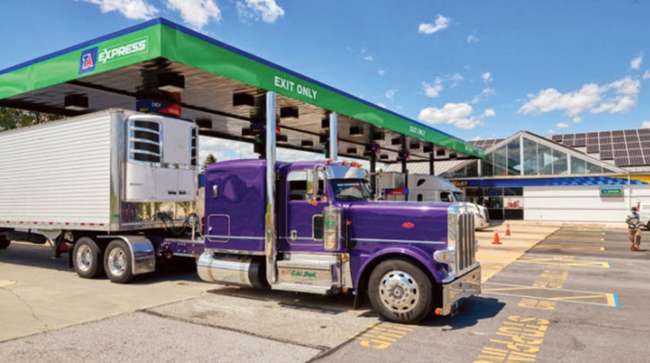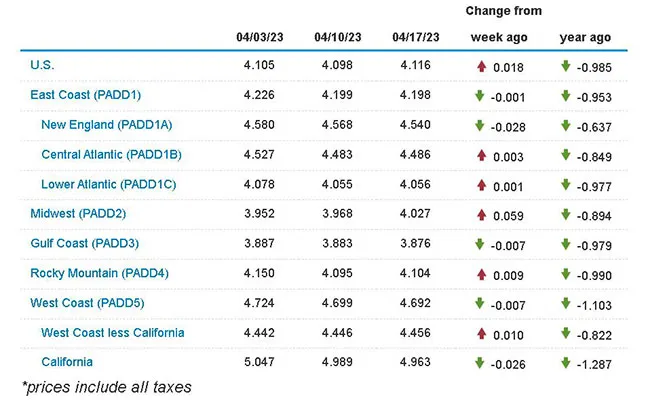Staff Reporter
Diesel Bumps Up 1.8¢ to $4.116 a Gallon

[Stay on top of transportation news: Get TTNews in your inbox.]
Diesel’s national on-highway average price ended its 10-week run of declines by rising 1.8 cents to $4.116 a gallon, according to Energy Information Administration data released April 17.
The average price for a gallon of diesel had fallen each week since it cost $4.622 on Jan. 30.
A gallon of trucking’s main fuel now costs 98.5 cents less than it did at this time a year ago.
On-highway diesel’s average price rose in five of the 10 regions in EIA’s most recent weekly survey and fell in five. The biggest increase was 5.9 cents in the Midwest. The biggest drop was 2.8 cents in New England.
Despite the average price gain of 1.8 cents, an on-highway gallon of diesel remained below $5 in all 10 regions for the second consecutive week.
U.S. On-Highway Diesel Fuel Prices

EIA.gov
In the Midwest, wholesale market differentials rose this week as a result of a number of factors, including lower-than-expected supplies from elsewhere in the United States, said David Thompson, executive vice president at Powerhouse, a broker based in Washington. Those deliveries largely arrive on Explorer Pipeline, which starts just outside Houston and terminates just outside Chicago.
Another factor, Thompson said, was demand from the agricultural sector. A third factor was the performance of regional refineries. Suncor last week shut a unit at its 103,000-barrel-a-day Commerce City refinery in Colorado for two months, according to published reports.

Thompson
Conversely, diesel differentials in California got crushed this week on the back of weak demand and expectations of imports, Thompson said.
On-highway gasoline rose 6.7 cents a gallon on average to reach $3.663 a gallon, EIA data showed April 17. That’s 40.3 cents less than it cost at this time in 2022, it added.
But increased refinery capacity and higher associated gasoline and diesel production should put downward pressure on fuel prices this summer compared with 2022, EIA said when releasing additional data April 19.
At the same time, greater refinery production may be counteracted at least in part by the effects of higher crude oil prices and low inventories, the agency added.
Those prices have encouraged more drilling. Baker Hughes said the U.S. rig count totaled 748 in the week that ended April 14, down three rigs compared with April 6 (data issued early due to Good Friday holiday), but was 55 rigs higher than a year earlier.
Front-month West Texas Intermediate crude has been on the rise since the middle of March, when WTI futures bottomed out at a close of $66.74 a barrel, its lowest end-of-day figure in the past year, and not far off its overall 52-week low of $64.12 a barrel.
So far in 2023, the diesel crack spread decreased from $1.20 a gallon in January to 54 cents a gallon as of April 17, the federal agency said.

Anthony Marshall of UPS shares the gold standard for an efficient and effective EV maintenance cycle. Hear the program above and at RoadSigns.TTNews.com.
EIA noted that crack spreads are a method of looking at fuel prices minus the cost of crude oil and serve as an indicator of refinery profitability.
While the profitability of producing at refineries — a factor in how much supply enters the marketplace — may be on the on the rise, demand from trucking companies could counteract that.
American Trucking Associations’ advanced seasonally adjusted For-Hire Truck Tonnage Index fell 5.4% sequentially to 111.6 in March after increasing 0.9% in February.
There are clear signs domestic demand for goods is slowing, said Powerhouse’s Thompson, with its direct impact on trucking and diesel consumption — and therefore prices. How quickly the Chinese economy reopens after tough COVID-19 pandemic countermeasures and inflationary measures the U.S. Federal Reserve takes in the coming months will also be major factors, he added. However, unless there’s a dramatic rally, prices this coming summer will be lower year-over-year, Thompson said.
Want more news? Listen to today's daily briefing below or go here for more info:




